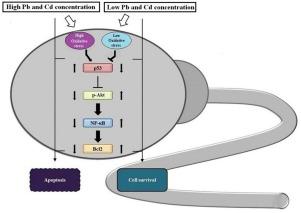Reproductive Toxicology ( IF 3.3 ) Pub Date : 2020-09-22 , DOI: 10.1016/j.reprotox.2020.09.006 Sreyashi Mitra 1 , Alex C Varghese 2 , Syamsundar Mandal 1 , Sayantan Bhattacharyya 1 , Parag Nandi 3 , Syed M Rahman 4 , Kushal Kumar Kar 5 , Rinku Saha 6 , Shubhadeep Roychoudhury 6 , Nabendu Murmu 1

|
The aim of this study was to evaluate the impact of Lead (Pb) and Cadmium (Cd) exposure at the molecular level on the reproductive status of tea garden workers in North-East India. Using semen samples, we experimentally determined sperm analysis as well as oxidative stress parameters in all samples and evaluated the expression levels of apoptotic and cell survival proteins [p53, phospho-Akt, nuclear factor-κB (NF-κB, p50 subunit) and B cell lymphoma 2 (Bcl2)]. Our data revealed significant differences in the average heavy metal concentrations and various semen analysis profile between the infertile and normal groups. Increasing Pb and Cd concentrations in semen samples of patients showed positive associations with increasing number of multiple defects in sperm and the level of seminal oxidative stress markers in the high Pb and Cd concentration groups. These groups also exhibited positive correlations between high metal concentrations and the average p53 expression levels, but negative correlations with the mean p-Akt cascade protein levels in sperm cells. In the low Pb and Cd concentrations groups, we also observed reverse mean range and correlation patterns. Therefore, our findings may suggest that graded levels of metal exposure significantly influence the relative fluctuation in the levels of p53 and Akt cascade proteins in the sperm cells of infertile subjects. Furthermore, this may be a regulating factor of sperm cell fate, in turn, determining the fertility outcome of the men working in the tea gardens.
中文翻译:

铅和镉暴露通过调节茶园工人凋亡和生存信号蛋白的表达谱诱导男性生殖功能障碍
本研究的目的是在分子水平上评估铅 (Pb) 和镉 (Cd) 暴露对印度东北部茶园工人生殖状况的影响。使用精液样本,我们通过实验确定了所有样本中的精子分析以及氧化应激参数,并评估了凋亡和细胞存活蛋白 [p53、磷酸-Akt、核因子-κB(NF-κB、p50 亚基)和 B 的表达水平细胞淋巴瘤 2 (Bcl2)]。我们的数据显示,不育组和正常组之间的平均重金属浓度和各种精液分析特征存在显着差异。患者精液样本中铅和镉浓度的增加与精子多发缺陷数量的增加以及高铅和镉浓度组的精液氧化应激标志物水平呈正相关。这些组还表现出高金属浓度与平均 p53 表达水平之间的正相关,但与精子细胞中的平均 p-Akt 级联蛋白水平呈负相关。在低 Pb 和 Cd 浓度组中,我们还观察到反向平均范围和相关模式。因此,我们的研究结果可能表明,金属暴露的分级水平显着影响不育受试者精子细胞中 p53 和 Akt 级联蛋白水平的相对波动。此外,这可能是精子细胞命运的调节因素,反过来,



























 京公网安备 11010802027423号
京公网安备 11010802027423号